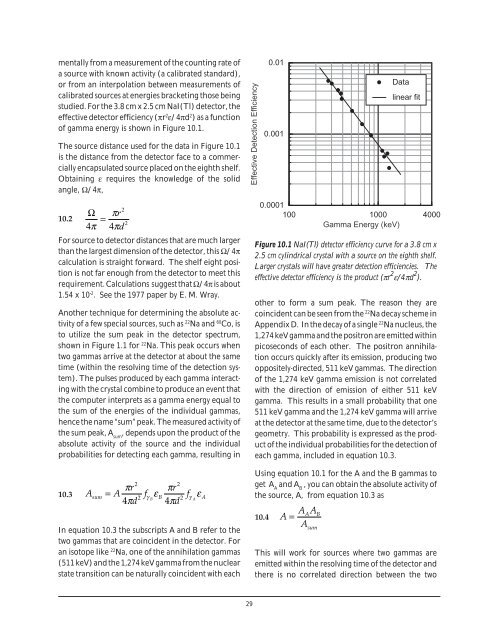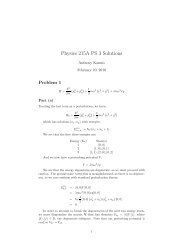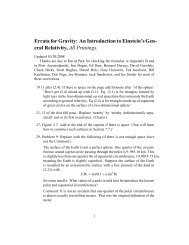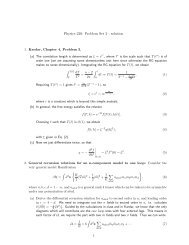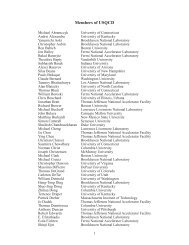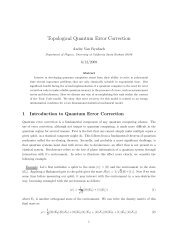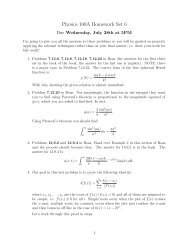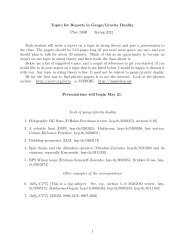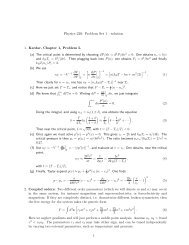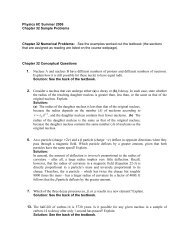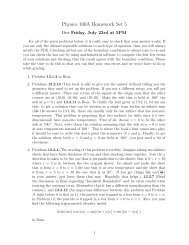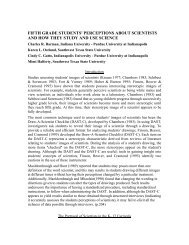Nuclear Spectroscopy
Nuclear Spectroscopy
Nuclear Spectroscopy
Create successful ePaper yourself
Turn your PDF publications into a flip-book with our unique Google optimized e-Paper software.
mentally from a measurement of the counting rate of<br />
a source with known activity (a calibrated standard),<br />
or from an interpolation between measurements of<br />
calibrated sources at energies bracketing those being<br />
studied. For the 3.8 cm x 2.5 cm NaI(Tl) detector, the<br />
effective detector efficiency (πr 2 ε/4πd 2 ) as a function<br />
of gamma energy is shown in Figure 10.1.<br />
The source distance used for the data in Figure 10.1<br />
is the distance from the detector face to a commercially<br />
encapsulated source placed on the eighth shelf.<br />
Obtaining ε requires the knowledge of the solid<br />
angle, Ω/4π,<br />
2<br />
Ω πr<br />
10.2 =<br />
2<br />
4π<br />
4πd<br />
For source to detector distances that are much larger<br />
than the largest dimension of the detector, this Ω/4π<br />
calculation is straight forward. The shelf eight position<br />
is not far enough from the detector to meet this<br />
requirement. Calculations suggest that Ω/4π is about<br />
1.54 x 10 -2 . See the 1977 paper by E. M. Wray.<br />
Another technique for determining the absolute activity<br />
of a few special sources, such as 22 Na and 60 Co, is<br />
to utilize the sum peak in the detector spectrum,<br />
shown in Figure 1.1 for 22 Na. This peak occurs when<br />
two gammas arrive at the detector at about the same<br />
time (within the resolving time of the detection system).<br />
The pulses produced by each gamma interacting<br />
with the crystal combine to produce an event that<br />
the computer interprets as a gamma energy equal to<br />
the sum of the energies of the individual gammas,<br />
hence the name “sum” peak. The measured activity of<br />
the sum peak, A sum<br />
, depends upon the product of the<br />
absolute activity of the source and the individual<br />
probabilities for detecting each gamma, resulting in<br />
10.3<br />
A A r 2<br />
2<br />
π<br />
=<br />
d f π<br />
ε<br />
rd f<br />
2 γ B 2<br />
4π<br />
4π<br />
sum B γ A A<br />
In equation 10.3 the subscripts A and B refer to the<br />
two gammas that are coincident in the detector. For<br />
an isotope like 22 Na, one of the annihilation gammas<br />
(511 keV) and the 1,274 keV gamma from the nuclear<br />
state transition can be naturally coincident with each<br />
ε<br />
Effective Detection Efficiency<br />
0.01<br />
0.001<br />
J J<br />
J J<br />
J<br />
Figure 10.1 NaI(Tl) detector efficiency curve for a 3.8 cm x<br />
2.5 cm cylindrical crystal with a source on the eighth shelf.<br />
Larger crystals will have greater detection efficiencies. The<br />
effective detector efficiency is the product (πr 2 ε/4πd 2 ).<br />
J<br />
J<br />
J<br />
J<br />
J J J<br />
0.0001<br />
100 1000 4000<br />
Gamma Energy (keV)<br />
J<br />
Data<br />
linear fit<br />
other to form a sum peak. The reason they are<br />
coincident can be seen from the 22 Na decay scheme in<br />
Appendix D. In the decay of a single 22 Na nucleus, the<br />
1,274 keV gamma and the positron are emitted within<br />
picoseconds of each other. The positron annihilation<br />
occurs quickly after its emission, producing two<br />
oppositely-directed, 511 keV gammas. The direction<br />
of the 1,274 keV gamma emission is not correlated<br />
with the direction of emission of either 511 keV<br />
gamma. This results in a small probability that one<br />
511 keV gamma and the 1,274 keV gamma will arrive<br />
at the detector at the same time, due to the detector’s<br />
geometry. This probability is expressed as the product<br />
of the individual probabilities for the detection of<br />
each gamma, included in equation 10.3.<br />
Using equation 10.1 for the A and the B gammas to<br />
get A A<br />
and A B<br />
, you can obtain the absolute activity of<br />
the source, A, from equation 10.3 as<br />
10.4<br />
A<br />
AA A<br />
=<br />
A<br />
sum<br />
B<br />
This will work for sources where two gammas are<br />
emitted within the resolving time of the detector and<br />
there is no correlated direction between the two<br />
29


